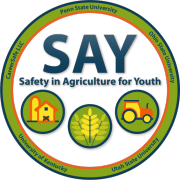 SAY Project Logo
SAY Project Logo
Special Note: The material below represents the original plans for the SAY project as stated in the 2013-15 project proposal. While much progress has been made toward the original goals and objectives, these and organizational structures shift over time. To stay abreast of SAY project changes, be sure to look at the annual SAY project reports at the bottom of the SAY Project homepage.

Project Vision
The mission of the Safety in Agriculture for Youth project (SAY) is to develop a sustainable and accessible national clearinghouse for agricultural safety and health curriculum for youth. This “national curriculum” is not a curriculum per se but is an umbrella compilation that includes many different curricula, programs, projects, and activities that together have a common purpose of increasing safety and health knowledge and reducing hazard and risk exposure to youth on farms and ranches. Additionally, this national curriculum must be sensitive to all types and scales of production agriculture and all ages and experience levels of target audiences; it must include parents and other educators; it must be culturally appropriate; and it must be usable in both formal and informal educational settings.
Project Goals
The goals of SAY are to coordinate a national curriculum and become a sustainable national clearinghouse by
- connecting and enhancing existing educational resources in this area;
- developing a centralized location for relevant training and farm and ranch safety materials for both formal (school) and informal (home and agricultural industry) settings; and
- developing a national strategy that would enhance awareness of, access to, and utilization of farm safety materials by youth and adults who instruct and/or work with youth.
Project Objectives
SAY has the following implementation objectives:
- Formulate the project team and identify and invite organizations to serve on the national steering committee and stakeholder groups.
- Identify formally all safety and health curricula for agricultural youth that possibly align to current nationally recognized core competencies and learning objectives or outcomes.
- Establish a protocol for development of a pool of exam items (test questions).
- Develop and deliver an Occupational Safety and Health Administration (OSHA)-approved, 10-hour, web-based youth agricultural safety and health training course.
- Develop and deliver an OSHA-approved, 10-hour, traditional (classroom-based and instructor-led) youth agricultural safety and health training course.
- Establish a risk-assessment protocol for developing supervision strategies and guidelines for formal secondary students’ experiential learning activities (that is, supervised agricultural experiences).
- Provide, through workshops, access to supervision and safety best practices and risk-assessment protocols.
- Develop an immersive, 3-D, virtual learning environment, in proof-of-concept form, teaching farm safety hazards to youth ages 13 to 15.
- Develop a sustainable process that ensures user-friendly access to educational resources and expertise.
- Develop and implement a national strategy to promote awareness and utilization of youth safety materials by diverse stakeholder audiences.
- Develop and implement a national strategy to increase use of youth safety materials through eXtension.org/agsafety.
Project Organization Chart
This two-year project began in September 2013 and will use the project team, a national steering committee, and four stakeholder groups (shown below) to complete the stated objectives.

